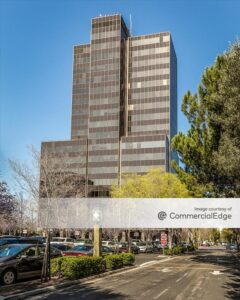Sage’s CEO on the New Realities of Manhattan’s Office Market
In the ever-evolving New York City commercial real estate market, Class A office spaces have remained a key focus for top-tier tenants, despite the challenges brought on by the pandemic, rising interest rates and shifts in workplace models. These premium office environments, characterized by their prime locations, high-quality amenities and modern design, continue to shape the future of work in the city’s iconic skyline.
Commercial Property Executive reached out to Sage CEO & President Jonathan Kaufman Iger to discuss how Class A office landlords are adapting to tenants and office users’ evolving expectations.
Sage owns and operates six Class A office buildings in Manhattan totaling more than 3 million square feet. The company’s approach to creating spaces that foster collaboration, productivity and wellbeing is helping redefine the future of urban workspaces in New York City.
READ ALSO: What Makes a Distressed Office Property a Good Investment?
Manhattan’s office market has been through a lot over the past few years. How has demand for Class A office space performed lately?
Iger: Despite the challenges Manhattan’s office market has faced, we continue to see steady demand for Class A space. High-quality, well-located buildings are still drawing interest, especially from firms that prioritize the long-term productivity and wellbeing of their teams. Tenants are now more selective, seeking environments that support collaboration, wellness and innovation, which is why we’re focusing on designing spaces and curating experiences that align with these evolving needs.
What do Class A office tenants expect today, particularly in terms of amenities and design?
Iger: Today’s Class A tenants expect more than just premium office space—they want a holistic experience that enhances both productivity and employee satisfaction. Location remains key, but proximity to transit hubs, vibrant neighborhoods and lifestyle amenities plays a larger role.
We have introduced Oasis amenities at 437 Madison Ave. and 767 Third Ave., with plans to bring it to 777 Third Ave. next. Fogarty Finger-designed Oasis hosts beautifully designed amenity spaces for dining, meeting, conferencing and socializing. These kinds of amenity spaces, facilitating community and fostering collaboration, have become nonnegotiable in attracting and retaining top talent.
Can you expand on the health-oriented amenities your properties include?
Iger: We’ve made employee (member) wellbeing a cornerstone of our offerings. In addition to our oasis spaces and wellness and fitness partnerships, our property management and member experience ensemble prioritizes meeting with and learning as much as possible about our tenants, which helps us strategically plan programming and curated experiences.
We understand that work-life balance requires dynamic partnerships with innovative organizations to benefit our members. For example, one of our lifestyle services partners, Pumpspotting, offers comprehensive lactation solutions and support systems to Sage members and their families right in the palm of their hands.
Most of your spaces are in iconic buildings. How do you balance maintaining the historic value of your buildings and incorporating modern amenities and smart technology?
Iger: As a 100-year-old family business, Sage is incredibly proud of our unwavering commitment to New York City and we are thrilled to contribute to its vibrant future by enhancing our properties and exploring new opportunities for growth. We offer cutting edge amenity spaces and technology integration, like our new Sage Connected 2.0 app and Sage Passport—which allow members to utilize amenities across the portfolio, regardless of their office location.
Equally, we appreciate the storied history of our buildings. 767 Third Ave., for example, was recently featured in a book about interesting places around New York for its iconic chessboard—known as the world’s largest—on the side of the building. Introduced in 1982, the board mirrors famous games of chess through changing moves.
Can you provide examples of recent renovations or enhancements made to your buildings to meet the changing needs of tenants?
Iger: We regularly look at updates to our properties, not only for tenant satisfaction but also for a more sustainable future. At 437 Madison Ave., Sage has made some recent back-of-house capital upgrades for the property. Ownership has installed a tier four backup generator to support the fire and life safety essential systems, configured with the support of base-building mechanical loads. The installation includes additional capacity to support critical loads for tenants.
Currently, Sage is renovating the base-building central cooling plant, including upgrades to all auxiliary equipment, pumps, motors, valves and building automation controls, to optimize the control capabilities and efficiencies. Ownership is also installing digital steam distribution controls and upgrades, which are projected to reduce overall steam consumption and maximize steam distribution.
A $60 million lobby and plaza arcade capital improvements program and an Oasis amenity space have transformed the tower into an iconic Manhattan property for the most discerning tenants. Featuring state-of-the-art building systems and technology, 437 Madison Ave. is uniquely desirable among Manhattan’s finest office destinations. The Fogarty Finger-designed lobby, arcade and elevator cabs, as well as the MPFP-designed ground level Plaza Garden, and the 15th floor Terrace Garden, make this luxury property not only a classic, but an architectural destination.
To what extent have high interest rates and inflation impacted your leasing strategy?
Iger: A challenging market has made us more dynamic. We needed to innovate not only on tenant and member experience, but also in regard to how we approach future investments. As part of routine portfolio evaluations, we identify options that are highly accretive to Sage and beneficial to the changing landscapes of the communities we serve. We also take care to listen to what prospective tenants are looking for from their offices, options like 24/7 HVAC and ease of access, and tailor our offerings to meet their needs.
Work has forever changed and Sage has redefined the future of the office experience. Sage enriches the lives of people at work by providing beautifully designed spaces, exceptional service and inspiring experiences that elevate and enhance the everyday, so our tenants and members can achieve more. We believe the modern, innovative office complements these new hybrid working patterns—better serving a more dynamic workforce.
What’s your approach toward flexible office environments given the increasing demand for coworking spaces and adaptable office layouts?
Iger: We have long seen collaboration as one of the most important tenets of the modern office space. Our workplace solutions and Oasis spaces are designed with this collaboration and adaptability in mind—hosting an array of private and public spaces, conference rooms and phone booths, to meet the needs of our members. The goal is to ensure that our tenants can remain flexible while still enjoying the premium amenities and locations inherent to our portfolio.
What’s the future of Class A office space in urban core areas of gateway cities like New York City? Do you expect any major shifts over the next few years?
Iger: Class A office space will continue to play a critical role in urban core areas like New York City, but the expectations surrounding these spaces are evolving. Over the next few years, we anticipate greater emphasis on sustainability, flexibility and health-focused design. Tenants will seek out spaces that are not only well-located but also adaptable to hybrid work models and equipped with the latest technologies. In response, landlords must remain agile, continuously updating their offerings to meet the demands of a more discerning and dynamic tenant base.
The post Sage’s CEO on the New Realities of Manhattan’s Office Market appeared first on Commercial Property Executive.



